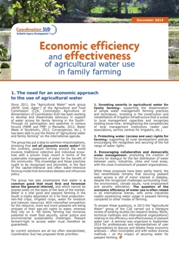- Accaparement des terres
-
Politiques foncières
- Refonder la politique foncière agricole de la France
- Politiques foncières et histoire agraire en Europe
- Les politiques foncières agricoles de la France au XXe siècle
- Le foncier en Afrique de l’Ouest. Fiches pédagogiques.
- Réformes Agraires dans le Monde
- Expérience du Code Rural au Niger
- Politiques foncières et Réforme Agraire. Cahier de Propositions.
- Forêts
- Eau
- Gouvernance des territoires
- FMAT - Forum Mondial sur l’Accès à la Terre 2016
- Autres Conférences et Forums internationaux
- Conférences filmées - Réunions Thématiques AGTER
- Entretiens avec des membres d’AGTER
- Formation - Enseignement
- Formation - Voyages d’étude
- Formation - Modules courts
- Editoriaux - Bulletin d’information d’AGTER
- Préserver l’environnement et les grands équilibres écologiques
- Développer la participation des peuples à la prise de décision aux niveaux national et local
- Respecter les droits humains fondamentaux. Lutter contre les inégalités
- Mettre en place une gouvernance mondiale efficace. Construire la paix
- Assurer l’efficience de la production agricole. En finir avec la faim
- Valoriser et entretenir la diversité culturelle
- Prendre en compte les besoins des générations futures. Gérer les « communs »
Recherche dans les titres, sous-titres, auteurs sur www.agter.org et sur www.agter.asso.fr
Recherche en plein texte sur www.agter.org avec Google
Rechercher dans le moteur Scrutari de la Coredem (multi-sites)
Version française de cette page : Efficience et efficacité économique de l’usage de l’eau agricole par les agricultures familiales
Economic efficiency and effectiveness of agricultural water use in family farming
A paper produced by Coordination Sud
Rédigé par : Michel Merlet, Frédéric Apollin, Patricia Toelen, Yves Richard
Date de rédaction :
Organismes : Association pour contribuer à l’Amélioration de la Gouvernance de la Terre, de l’Eau et des Ressources naturelles (AGTER), Groupe de Recherches et d’Echanges Technologiques (GRET), Agronomes et Vétérinaires Sans Frontières (AVSF), Coordination nationale des ONG françaises de solidarité internationale (Coordination Sud)
Type de document : Article / document de vulgarisation
Résumé
In Brief
Since 2011, the “Agricultural Water” working group (AVSF, Gret, Agter) of the Agriculture and Food Commission (C2A, Commission Agriculture et Alimentation) of Coordination SUD has been working to develop and disseminate advocacy in support of water access for family farming in the South.

The group has put a stop to common misconceptions, stressing that not all peasants waste water ! On the contrary, peasant farming around the world involves traditional collective and individual know how with a proven track record in terms of the sustainable management of water for the benefit of the community. This knowledge and these practices ought to be recognized and promoted, in the face of the capital-intensive and often water-intensive farming model that dominates debates and influences policy.
Water is a common good that must first and foremost serve the general interest, and which cannot be shared solely on the basis of the laws of the market.
After recalling the need for an economic approach to agricultural water and using different examples, the authors examine how the economic efficiency of the use of agricultural water can be addressed : What is the net wealth created ? How is it distributed ? What indirect effects may be generated by the various forms of water use.
While the economic efficiency of agricultural water use is an important criterion to steer investment policies and programmes, or to prioritize certain types of use and users, the analysis and measurements carried out by both public and private actors until now have only partially taken into account all the above- mentioned elements: the value added created per ha and m³ of water, the modalities of redistribution and jobs created, and the externalities generated, whether positive or negative.
To do so, it is important to carry out analyses of agrarian systems taking collateral effects and the benefits and cost induced into account from the outset. Studies should not just consider the catchment area in which water is collected, but also the “extra-catchment” area in which the water is redistributed, as well as the adjacent coastal area. In other words, it is necessary to resituate the reality observed in the cycles of the water used.
We will have also to make use of prices that correct most of the artificial effects produced by subsidies or by the existence of uncompetitive markets.
Finally, taking into account future generations and the long term will require analyses that cannot be based solely on quantitative evaluations.
In these conditions, the assumption that water can become a commodity like any other makes no sense. Nor is it a public good which everyone could access free of charge. It is at once a public good, a common good –sometimes common to several distinct communities–, and a private good. But it is thus not the same water at stake in each case, even though all these waters are essentially comprised of H2O molecules.
These are the differences that need to be highlighted in order to pursue and deepen the reflection surrounding the social justice in water issues and to understand when and how, economically speaking, access to agricultural water for small farmers is in the interests of humanity as a whole.
The full version of this paper can be downloaded on this page.
Télécharger le document
Dossier
Défis
- Gérer durablement l’eau douce
- Créer plus de richesses nettes et d’emplois par unité de surface
- Appuyer les agricultures paysannes avec des politiques publiques adaptées
- Reconnaître les savoir-faire des paysans, des pasteurs, des chasseurs cueilleurs, des pêcheurs
- Reconnaître le caractère de « commun » de toute ressource naturelle
Traductions
- Eficiencia y eficacia económica del uso del agua agrícola por parte de la agricultura familiar
- Efficience et efficacité économique de l’usage de l’eau agricole par les agricultures familiales
- Eficiência e eficácia econômica da utilização da água agrícola pelas agriculturas familiares
Organismes




 Agter participe à la Coredem
Agter participe à la Coredem